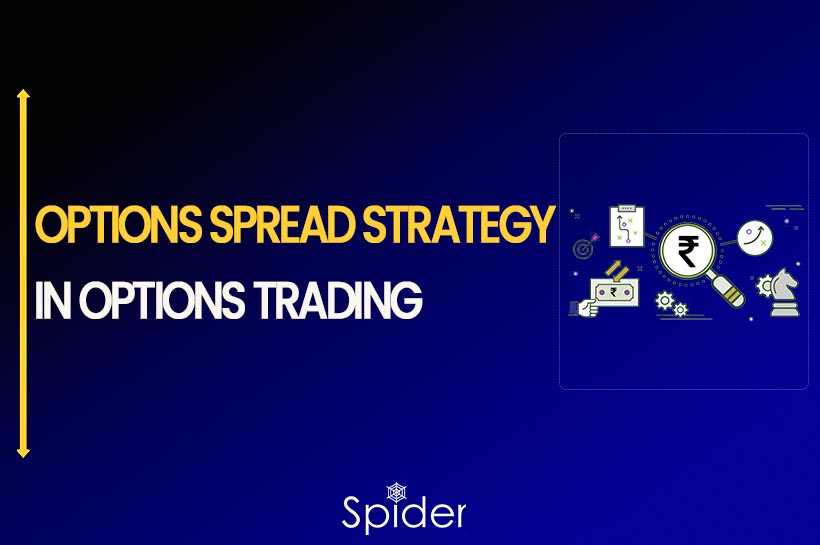An options spread strategy in options trading involves combining multiple options positions to take advantage of price movements, volatility, or time decay.
How does Options Spread work?
A spread trade in options involves buying one asset while simultaneously selling another. It acts as a bridge connecting multiple options, reducing the risk associated with holding a single option. However, it’s important to understand how spread trading works, know your investing mindset, and consider your risk tolerance before implementing spread strategies in your portfolio.
What actually is an Options Spread Trade?
In options trading, a spread is a strategy that involves buying one option’s contract and selling another. You can use options of the same type (puts or calls) for the same underlying asset. A spread trade can either cost you money or make you money, depending on the premiums of the options involved.
A vertical spread involves options with different strike prices but the same expiration date, while a horizontal spread involves options with the same strike prices but different expiration dates.
There are other types of spreads, like ratio spreads, diagonals, butterflies, and condors. Remember to obtain thorough research before you start spread trading.
What are the Different Types of Options Spread Trading Strategies?
- There are different types of options spread strategies commonly used in options trading. Here are a few examples:
- Vertical Spreads: This strategy involves buying and selling options of the same type (calls or puts) on the same underlying asset but with different strike prices. It includes strategies like bull call spreads, bears put spreads, bull put spreads, and bear call spreads.
- Calendar Spreads: This strategy involves buying and selling options of the same type on the same underlying asset but with different expiration dates. Traders aim to take advantage of differences in time decay and volatility between the options.
- Diagonal Spreads: This strategy combines elements of vertical and calendar spreads. It involves buying and selling options of the same type on the same underlying asset but with different strike prices and expiration dates.
- Butterfly Spreads: This strategy combines long and short options positions with different strike prices. It aims to profit from a specific range of prices for the underlying asset.
- Condor Spreads: Similar to butterfly spreads, condor spreads involve a wider range of strike prices. Traders use a combination of long and short options positions to profit from a range of prices for the underlying asset.
- Ratio Spreads: This strategy involves buying and selling an uneven number of options contracts. Traders aim to benefit from changes in volatility or the price of the underlying asset.
- Credit Spreads: These spreads involve selling options with a higher premium and buying options with a lower premium. The goal is to receive a net credit upfront.
- Debit Spreads: These spreads involve buying options with a higher premium and selling options with a lower premium. The goal is to pay a net debit upfront. These strategies have different risk-reward profiles and are used in various market conditions based on traders’ outlooks and risk tolerance.
What are the Advantages of Options Spread in the Indian Market?
Spread trading in the Indian stock market has several benefits. It helps manage risk by combining long and short positions, offsetting potential losses. It also acts as an effective hedging technique to protect existing positions. Spread trading can generate income through premiums received from selling options. It offers flexibility to adjust positions according to market conditions. Strategies like calendar spreads and condor spreads can be profitable in range-bound markets. Spread trading requires less capital and allows for portfolio diversification. Traders must understand their chosen strategies, assess risk tolerance, and align with investment goals before participating in spread trading in the Indian stock market,
What are the Drawbacks associated with Spread Trading in the Indian Market?
Spread trading in the Indian market has drawbacks. It limits profits compared to directional trading. It is complex, involving different options contracts, strike prices, and expiration dates. Multiple transactions increase trading costs. Market volatility affects profitability. Limited liquidity can make trade execution challenging. Regulatory compliance with SEBI is necessary, including approvals and margin requirements. Traders should consider these drawbacks before spreading trading in the Indian market.
An example of an Options Spread
Example of a bullish vertical spread:
Assume a stock is priced at ₹140 and you expect it to rise to ₹150. To limit potential losses, you can use a bullish vertical spread strategy.
Here’s how it works: Buy a call option with a strike price of ₹135 for ₹9.30 (pay the premium) and sell a call option with a strike price of ₹150 for ₹2.50 (receive the premium). Both options expire in 45 days.
To open these options, pay a total premium of ₹6.80 (₹9.30 – ₹2.50). The spread is ₹15 (₹150 – ₹135).
In a profitable scenario, if the market reaches or exceeds ₹150 at expiration, sell the ₹135 call option for a profit that exceeds the loss on the ₹150 call option. Maximum profit is ₹8.20 (spread width – premium).
In a loss scenario, if the market falls below ₹135 at expiration, both options expire worthless. However, you gain the ₹2.50 premium received from selling the ₹150 call option, reducing the loss. Maximum loss is ₹6.80 (premium paid). The maximum loss and maximum profit together equal the spread width (₹15) in this example (₹6.80 + ₹8.20 = ₹15).
To Sum Up
To summarize, options spread trading is a strategy that involves combining multiple options positions to take advantage of various market scenarios. It provides traders with flexibility, risk management, and potential profit opportunities. By using different types of spreads like vertical spreads, horizontal spreads, diagonal spreads, butterfly spreads, and more, traders can adapt to different market conditions and control their risk exposure. Spread trading allows for potential income generation, downside protection, and the ability to capitalize on price movements within a specific range. Traders need to understand the specific strategies they use, consider their risk tolerance, and align their objectives before engaging in options spread trading.
Also, Check out our article on Factors Behind Nifty’s All-Time High Achievement 2023.
Disclaimer: The information provided in this Blog is for educational purposes only and should not be construed as financial advice. Trading in the stock market involves a significant level of risk and can result in both profits and losses. Spider Software & Team does not guarantee any specific outcome or profit from the use of the information provided in this Blog. It is the sole responsibility of the viewer to evaluate their own financial situation and to make their own decisions regarding any investments or trading strategies based on their individual financial goals, risk tolerance, and investment objectives. Spider Software & Team shall not be liable for any loss or damage, including without limitation any indirect, special, incidental or consequential loss or damage, arising from or in connection with the use of this blog or any information contained herein.





